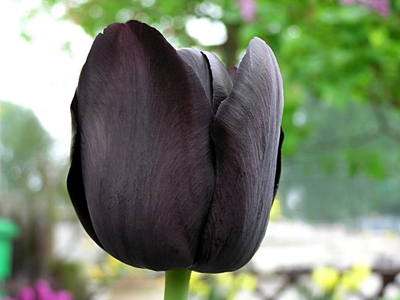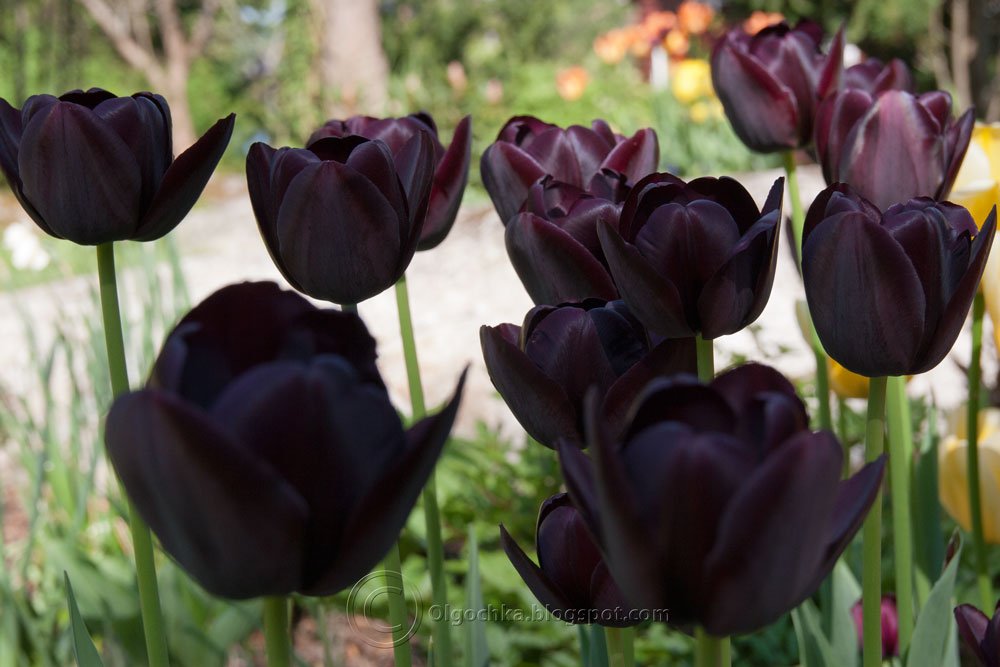| Annual / Summer and winter bulbs / Black Tulip Bulbs - Queen-of-the-Night |
|
|
|
|
| |
|
Plant name - Black Tulip |

|
|
 |
|
 |
| Common name - Black Tulip
|
| Plant type - Flowers |
| Vegetation type -
Annual |
| Growth rate - fast |
| Leaf / Flower color
- Green / Black |
| Other names - Queen-of-the-Night |
| |
| Description : |
Tulips are spring-blooming perennials that grow from bulbs. Depending on the species, tulip plants can be between 4 inches (10 cm) and 28 inches (71 cm) high. The tulip's large flowers usually bloom on scapes with leaves in a rosette at ground level and a single flowering stalk arising from amongst the leaves.Tulip stems have few leaves. Larger species tend to have multiple leaves.
Plants typically have two to six leaves, some species up to 12. The tulip's leaf is strap-shaped, with a waxy coating, and the leaves are alternately arranged on the stem; these fleshy blades are often bluish green in color. Most tulips produce only one flower per stem, but a few species bear multiple flowers on their scapes (e.g. Tulipa turkestanica).
The generally cup or star-shaped tulip flower has three petals and three sepals, which are often termed tepals because they are nearly identical. These six tepals are often marked on the interior surface near the bases with darker colorings.
Tulip flowers come in a wide variety of colors, except pure blue (several tulips with "blue" in the name have a faint violet hue).
The flowers have six distinct, basifixed stamens with filaments shorter than the tepals. Each stigma has three distinct lobes, and the ovaries are superior, with three chambers. The tulip's seed is a capsule with a leathery covering and an ellipsoid to globe shape. Each capsule contains numerous flat, disc-shaped seeds in two rows per chamber. These light to dark brown seeds have very thin seed coats and endosperm that does not normally fill the entire seed.
.
|
| |
| Growing Instructions : |
* Tulip bulbs offer a colorful addition to your home. The added benefit to growing them inside is that you do not have to wait until spring for color. Most people grow tulips indoors to "force" them, meaning to make them bloom at a different time than they would normally bloom. Knowledge of how to plant tulip bulbs indoors can help you brighten up the winter and add a unique decoration to your home.
* Obtain a clay or plastic pot with drainage holes in the bottom. Place gravel in the bottom of the pot for added drainage. Fill the pot most of the way with a mix of equal parts peat moss, sand and good garden loam.
* Place the tulip bulbs on top of the soil with the pointed end facing upward and the flat side facing the outside of the pot. This will ensure that the long leaves will flop over the sides of the pots. Adjust the soil level so that the top of the bulb is even with the rim of the pot. Place five bulbs in a 5-inch pot and six bulbs in a 6-inch pot.
* Place more of the potting medium around the bulbs to secure them in place. Allow the top of the tulip bulb to stick out of the soil. Water the bulbs deeply.
* Put the potted tulips in a cool area with temperatures between 35 and 48 degrees Fahrenheit for 12 to 13 weeks. The tulips need this cold treatment to bloom. A refrigerator or unheated cellar should do the trick. Make sure the tulip bulbs have complete darkness and water them frequently so they stay moist.
* Remove the tulips after the cold treatment. They should have yellow shoots at this point. Move them to a cool area between 50 and 60 degrees Fahrenheit (10 and 15 celsius) with low to medium light for four to five days. In this time the shoots should turn green. Maintain moisture in the pot.
* Move the pot to a brightly lit location with temperatures between 60 and 70 degrees Fahrenheit (15 and 21 celsius). Turn the pot periodically so the tulips grow upright. Keep the potting medium moist. The tulips should bloom in three to four weeks.
|
| |
|
|
|
|
|
